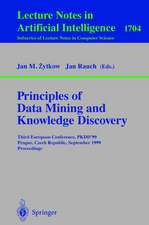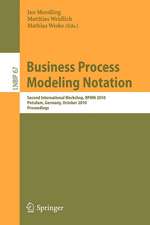Business Process Management: Concepts, Languages, Architectures
Autor Mathias Weskeen Limba Engleză Paperback – 10 iun 2014
Matthias Weske argues that all communities involved need to have a common understanding of the different aspects of business process management. To this end, he details the complete business process lifecycle from the modeling phase to process enactment and improvement, taking into account all different stakeholders involved. After starting with a presentation of general foundations and abstraction models, he explains concepts like process orchestrations and choreographies, as well as process properties and data dependencies. Finally, he presents both traditional and advanced business process management architectures, covering, for example, workflow management systems, service-oriented architectures, and data-driven approaches. In addition, he shows how standards like WfMC, SOAP, WSDL, and BPEL fit into the picture.
This textbook is ideally suited for classes on business process management, information systems architecture, and workflow management. This 2nd edition contains major updates on BPMN Version 2 process orchestration and process choreographies, and the chapter on BPM methodologies has been completely rewritten. The accompanying website www.bpm-book.com contains further information and additional teaching material.
| Toate formatele și edițiile | Preț | Express |
|---|---|---|
| Paperback (2) | 339.34 lei 6-8 săpt. | |
| Springer Berlin, Heidelberg – 15 aug 2020 | 339.34 lei 6-8 săpt. | |
| Springer – 10 iun 2014 | 437.85 lei 39-44 zile | |
| Hardback (2) | 421.23 lei 3-5 săpt. | +36.62 lei 6-12 zile |
| Springer Berlin, Heidelberg – 15 iul 2024 | 421.23 lei 3-5 săpt. | +36.62 lei 6-12 zile |
| Springer Berlin, Heidelberg – 4 mai 2012 | 516.02 lei 6-8 săpt. |
Preț: 437.85 lei
Nou
83.79€ • 89.59$ • 69.86£
Carte tipărită la comandă
Livrare economică 14-19 aprilie
Specificații
ISBN-10: 3642444415
Pagini: 420
Dimensiuni: 155 x 235 x 22 mm
Greutate: 0.59 kg
Ediția:2nd ed. 2012
Editura: Springer
Colecția Springer
Locul publicării:Berlin, Heidelberg, Germany
Public țintă
Professional/practitionerCuprins
Part I Foundation.- Introduction.- Evolution of Enterprise Systems Architectures.- Part II Business Process Modelling.- Business Process Modelling Foundation.- Process Orchestrations.- Process Choreographies.- Properties of Business Processes.- Part III Architectures and Methodologies.- Business Process Management Architectures.- Business Process Management Methodology.
Recenzii
“The subject Business process management is of interest to professional in business administration and computer science. … The author opines that both the communities need to have a common understanding of the different aspects of business process management. In this context, he details the complete business process lifecycle from the modeling phase to process enactment and improvement, taking into account all different stakeholders involved. … This is an ideal text book for the students for CSE & business administration.” (CSI eNewsletter, Vol. 3 (10), November, 2012)
Notă biografică
Mathias Weske is Professor of Software Systems Technology at the Hasso Plattner Institute for Software Systems Engineering at the University of Potsdam, Germany, where he leads the business process technology research group. His current research interests include various topics in workflow management, web services technology, and enterprise application integration. He is a member of the GI, vice chair of the executive committee of GI SIG EMISA, and a member of IEEE and ACM.
Textul de pe ultima copertă
Business process management is usually treated from two different perspectives: business administration and computer science. While business administration professionals tend to consider information technology as a subordinate aspect in business process management for experts to handle, by contrast computer science professionals often consider business goals and organizational regulations as terms that do not deserve much thought but require the appropriate level of abstraction.
Mathias Weske argues that all communities involved need to have a common understanding of the different aspects of business process management. To this end, he details the complete business process lifecycle from the modeling phase to process enactment and improvement, taking into account all different stakeholders involved. After starting with a presentation of general foundations and abstraction models, he explains concepts like process orchestrations and choreographies, as well as process properties and data dependencies. Finally, he presents both traditional and advanced business process management architectures, covering, for example, workflow management systems, service-oriented architectures, and data-driven approaches. In addition, he shows how standards like WfMC, SOAP, WSDL, and BPEL fit into the picture.
This textbook is ideally suited for classes on business process management, information systems architecture, and workflow management. This 2nd edition contains major updates on BPMN Version 2 process orchestration and process choreographies, and the chapter on BPM methodologies has been completely rewritten. The accompanying website www.bpm-book.com contains further information and additional teaching material.
Caracteristici
Presents both traditional and advanced business process management architectures, like e.g. workflow management systems and service-oriented architectures
Shows how standards like WfMC, SOAP, WSDL, and BPEL fit into the picture
Accompanying website www.bpm-book.com contains additional teaching material
Textbook material tested in many industrial and academic courses
Descriere
Business process management is usually treated from two different perspectives: business administration and computer science. While business administration professionals tend to consider information technology as a subordinate aspect in business process management for experts to handle, by contrast computer science professionals often consider business goals and organizational regulations as terms that do not deserve much thought but require the appropriate level of abstraction.
Matthias Weske argues that all communities involved need to have a common understanding of the different aspects of business process management. To this end, he details the complete business process lifecycle from the modeling phase to process enactment and improvement, taking into account all different stakeholders involved. After starting with a presentation of general foundations and abstraction models, he explains concepts like process orchestrations and choreographies, as well as process properties and data dependencies. Finally, he presents both traditional and advanced business process management architectures, covering, for example, workflow management systems, service-oriented architectures, and data-driven approaches. In addition, he shows how standards like WfMC, SOAP, WSDL, and BPEL fit into the picture.
This textbook is ideally suited for classes on business process management, information systems architecture, and workflow management. This 2nd edition contains major updates on BPMN Version 2 process orchestration and process choreographies, and the chapter on BPM methodologies has been completely rewritten. The accompanying website www.bpm-book.com contains further information and additional teaching material.



















